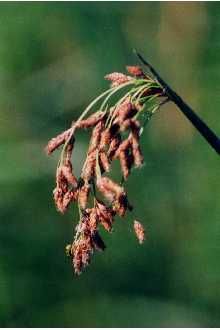New Moon Nurseries

Photo credit: Jennifer Anderson @ USDA-NRCS PLANTS Database. Soft stemmed bulrush is a wetland species. Good choice for wetland restorations and erosion control.
Scirpus validus (tabernaemontani)
Soft stemmed bulrush
Native to North America
FIRST IMPRESSIONS: Scirpus validus is a rhizomatous cool season perennial with tall dark green triangular culms. Leaf sheaths wrap the culm but blades are insignificant or absent. From summer until fall, the stems are topped by pendulous reddish brown umbels. This contender is much too aggressive for small manicured gardens. Instead the tenacious roots and rhizomes are a boon for expansive wetland restoration projects and soggy sites with erosion issues.
HABITAT & HARDINESS: Scirpus validus is an obligate wetland plant that occurs through most of North America and in Eurasia.
Habitats include wet prairies, non-tidal marshes, swamps, fringes of lakes and ponds, sloughs, freshwater or brackish shorelines, inland shallow waters, mudflats and ditches along railroad and roadside right-of-ways. Plants are found in disturbed or undisturbed wetlands with little or no wave action.
This species is hardy from USDA Zones 3-9.
PLANT DESCRIPTION: Scirpus validus is an unbranched perennial sedge relative that forms dense colonies from strong vigorous rhizomes.
The triangular green culms are soft, spongy and up to 8’ tall. The culms are upright or curved with no obvious leaf blades.
Culms terminate in a 6” wide compound umbel. The umbel consists of ¼” ovoid rusty brown pubescent an scaly spikelets. Each inflorescence has a single basal bract less than 3” long that appears to be an extension of the culm. The umbel rays are spreading and usually drooping.
During summer, the spikelet florets have white styles. The styles persist after flowering becoming contorted and brown.
Each floret matures into a brown ovoid achene. The achenes are beaked and surrounded by 4-6 bristles that are longer than the seed.
Plants attain 6-8’ height with 4-5’ spread. This species usually forms colonies on shorelines or in shallow water.
CULTURAL & MAINTENANCE NEEDS: Scirpus validus prospers in sunny or partly sunny poorly drained or saturated sites.
The preference is for silty or peaty soils. Plants tolerate shallow standing water, mucky, clay or sandy soils. They also prosper in alkaline conditions and a wide range of salinity.
This species seeds itself and can spread vigorously by rhizomes. Avoid planting in sites with limited space and vulnerable less aggressive companions.
LANDSCAPE USES: Scirpus validus is valuable for stabilizing or restoring degraded sites, for wildlife food and cover and for Erosion Control. The species is planted in Restoration and Stormwater Management Projects. Plants are often installed as Groupings or Mass Plantings in Wetland situations.
COMPANION & UNDERSTUDY PLANTS: Try pairing Scirpus validus with Carex comosa, Carex lurida, Carex vulpinoidea, Iris versicolor, Mimulus ringens, Verbena hastata or Juncus effusus.
Scirpus pungens has similar appearance and cultural needs and can be substituted if needed.
TRIVIA: Scirpus validus is among the tallest of Scirpus spp. and is sometimes known as Tall Bulrush or Great Bulrush. This species differs from other Scirpus spp. due to its tall stature, lack of noticeable leaf blades, soft spongy culms and the short basal bracts of the umbel.
Scirpus validus is also known as Scirpus tabernaemontani, and Scirpus lacustris validus.
The seeds are a good food for ducks, rails and other wetland birds. The dense colonial growth provides cover and nesting material for wildlife.
Scirpus validus is reported to grow better in saline conditions than in fresh water.
Height:
6-8 ftSpread:
4-5 ftSpacing:
4 ftUSDA Hardiness Zone:
3-9Bloom Color:
Green, TanScirpus validus (tabernaemontani) Characteristics
Attracts Wildlife
- Songbirds
- Pollinators
Attributes
- Dried Flower
- Coastal
- Clay Soil
- Rain Garden
- Bog
- Naturalizing
- Interesting Foliage
- East-Coast Native
Exposure
- Full Sun to Partial Shade
Deer Resistant
- Deer Resistant
Flowering Months
- September
- August
- July
- June
- October
Foliage Color
- Green
Grass Season
- Warm Season Grass
Phytoremediation
- Pb-Lead
- Cu-Copper
- Cd-Cadmium
- Zn-Zinc
Salt Tolerance
- Medium
Season of Interest (Foliage)
- Winter
- Fall
- Summer
- Spring
Soil Moisture Preference
- Wet
- Wet to Moist